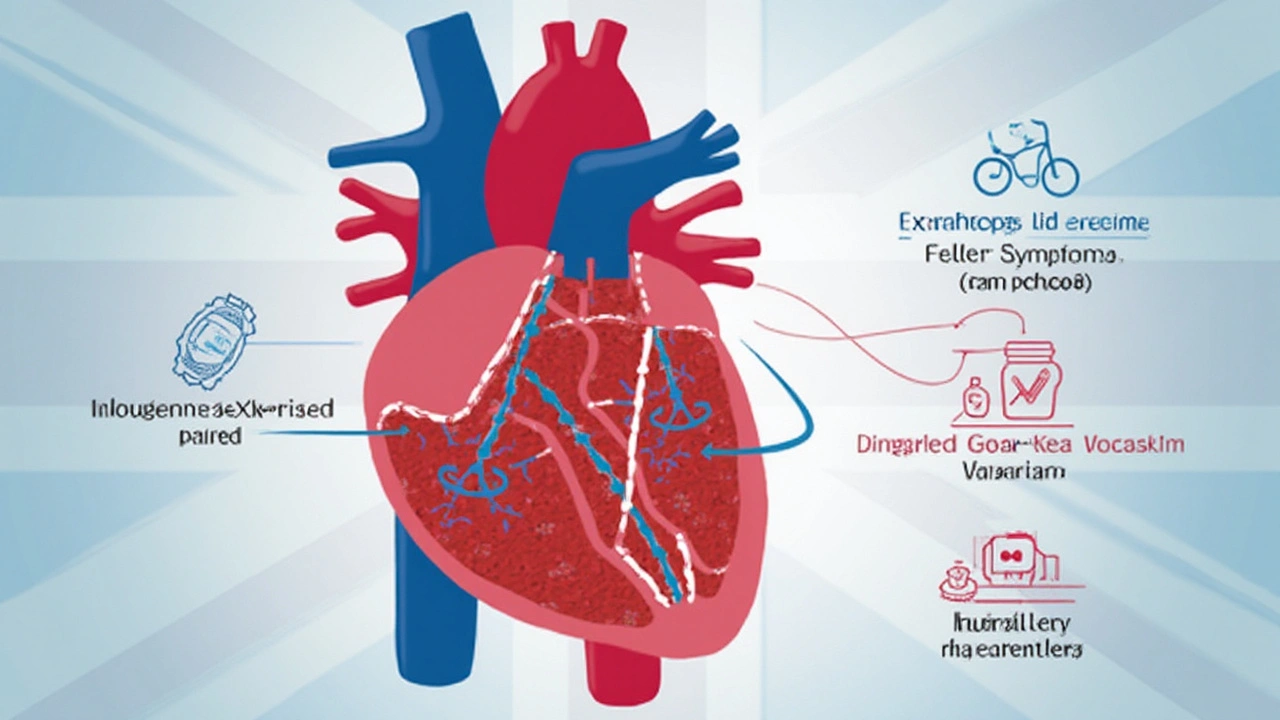
The numbers are tough: heart failure remains one of the leading reasons people end up in the hospital after age 65. Lots of folks feel frustrated by constant fatigue and shortness of breath, even when taking their daily meds. That’s where sacubitril steps up—it’s changed the landscape for heart failure treatment and isn’t just hype from drug companies.
So, what’s the buzz? Sacubitril, usually teamed up with valsartan in a combo pill, helps your heart work more efficiently. It does something older meds can’t—by blocking certain enzymes, it allows helpful body chemicals to stick around and support your heart. Less stress on the heart means you might breathe easier, do more, and spend fewer nights at the ER.
- How Sacubitril Works in the Heart
- Why Sacubitril Is Used With Valsartan
- Proven Benefits for Heart Failure Patients
- Key Tips for Taking Sacubitril Safely
- Comparing Sacubitril to Older Heart Failure Drugs
How Sacubitril Works in the Heart
Most heart failure drugs focus on blocking bad signals, but sacubitril does something extra. It’s what doctors call a neprilysin inhibitor. Basically, this means it blocks an enzyme (neprilysin) that breaks down useful substances in your body. When neprilysin is blocked, more of these helpful chemicals—like natriuretic peptides—stick around to help relax blood vessels, lower sodium, and make the heart’s job easier.
Here’s how it plays out in real life: with wider blood vessels, your heart doesn’t have to work as hard to pump blood. Less fluid builds up in your legs and lungs, so you breathe easier and stay more active. That’s a huge win for anyone dealing with symptoms day in and day out.
- Sacubitril boosts levels of protective hormones.
- It helps the body get rid of extra salt and water.
- It lowers blood pressure (sometimes a lot), which gives the heart a break.
Check out the numbers: In the PARADIGM-HF trial—a study with over 8,000 people—patients on sacubitril/valsartan were less likely to be hospitalized for heart failure compared to those on older meds. That’s real, day-to-day impact for people who just want to feel better and not be back in the hospital all the time.
| Effect of Sacubitril | Result |
|---|---|
| Hospitalizations Reduced | 20% fewer compared to traditional ACE inhibitors |
| Mortality Rate | Reduced by about 16% over two years |
If your heart’s not pumping strong, sacubitril gives it backup. That’s why heart doctors are excited about it—it’s moving us past just treating the symptoms and into actually improving how the heart functions.
Why Sacubitril Is Used With Valsartan
Here’s something many people don’t realize: sacubitril doesn’t do its best work alone. That’s why it always rides shotgun with valsartan, making the heart failure med known as an ARNI (angiotensin receptor-neprilysin inhibitor). Sure, the names sound intimidating, but the teamwork is what really matters.
Here’s what’s happening in the body. Sacubitril helps your system hold onto natural chemicals that relax blood vessels and lower sodium. This takes the edge off the heart. But ramping up these helpful chemicals can make another hormone (angiotensin II) go wild—which would raise blood pressure and undo the good stuff. That’s where valsartan steps in. It shuts down the effects of angiotensin II, keeping blood pressure in check and making the combo a win-win for your heart.
Doctors used to rely on older drugs that targeted just one pathway, but this duo tackles two at once. That means better blood flow, less stress on the heart muscle, and less swelling or fluid backup.
| Benefit | How Sacubitril-Valsartan Works |
|---|---|
| Reduces blood pressure | Sacubitril relaxes vessels, valsartan blocks angiotensin II |
| Lowers risk of hospitalization | Dual action keeps heart from overworking |
| Improves exercise ability | Less fluid backup, better heart pumping |
If you see a prescription for sacubitril alone, that’s a red flag—always check for the combo with valsartan. That’s the evidence-backed way to get all the benefits for people with heart failure.

Proven Benefits for Heart Failure Patients
If you’ve been dealing with heart failure, you know that feeling tired all day and gasping for air can become a way of life. Sacubitril is shaking things up for a ton of people in exactly this spot. We’re not just talking about tiny changes either—big studies have shown real, life-bettering results.
The most convincing data comes from a well-known study called PARADIGM-HF. When researchers looked at folks taking sacubitril with valsartan compared to those on the old standard, enalapril, the numbers didn’t lie. People using the new combo had fewer hospital visits and were less likely to die from heart failure or related causes. That’s a massive deal if you’re tired of the hospital grind or want less risk hanging over your head.
| Benefit | Sacubitril + Valsartan Group | Enalapril Group |
|---|---|---|
| Heart failure-related death | 16% | 18.5% |
| Hospitalization for heart failure | 12.8% | 15.6% |
People on sacubitril also said they felt less shortness of breath and were more able to handle daily things—like walking to the mailbox or climbing stairs. It all adds up to more good days at home, doing normal stuff, and less time stuck on a hospital bed or missing out because you’re beat.
The drug isn’t just for the sickest patients. Even if your symptoms aren’t that bad (yet), starting sacubitril early might help you avoid getting worse. Doctors recommend it for people with reduced ejection fraction, which basically means the heart’s not pumping as strong as it should.
If your doc suggests switching to sacubitril, remember it’s not just about numbers. It’s more energy, fewer scary moments, and feeling like you’ve got a bit more control. That’s why so many heart specialists are on board these days.
Key Tips for Taking Sacubitril Safely
If your doctor wants you to start sacubitril (usually with valsartan), it’s not as simple as popping the new pill. There are a few things you need to keep front-of-mind to get the benefits and dodge the more annoying side effects.
- Never combine it with an ACE inhibitor. If you’re on something like lisinopril or enalapril, you’ll need a 36-hour break before making the switch. Mixing them can raise your risk of serious swelling (angioedema).
- Stick to your schedule. Take sacubitril at the same time every day, with or without food. Setting a phone reminder helps (missing doses can make your symptoms flare up).
- Watch your blood pressure. This drug can drop your BP a bit too much, especially when you first start. If you notice dizziness, stand up slowly, and let your doctor know if it keeps coming back.
- Get regular blood tests. Your doctor will likely check potassium and kidney function while you’re on sacubitril. High potassium is a risk, and it can sneak up on you.
- Know the signs of trouble. If you notice swelling in the face, lips, or throat, trouble breathing, or severe stomach pain, get help right away—these could be signs of an allergic reaction.
| What to Watch | What It Means |
|---|---|
| Low Blood Pressure | Can cause dizziness or fainting, especially at first |
| High Potassium | May show as muscle weakness or irregular heartbeats |
| Kidney Function Changes | Could mean swelling or less urine than normal |
One more heads-up: Don’t stop taking sacubitril suddenly without asking your doctor. It might make your heart failure worse. And always check with your pharmacist or doctor about any new meds—even some over-the-counter drugs can interact with your heart medicine.

Comparing Sacubitril to Older Heart Failure Drugs
When it comes to treating heart failure, most folks have heard of ACE inhibitors (like enalapril) or ARBs (such as losartan). These meds have been the go-to for years—they lower blood pressure and help reduce strain on the heart. But sacubitril is part of a new group called ARNIs (angiotensin receptor-neprilysin inhibitors), and it’s shaking things up for good reason.
What’s the real difference? ACE inhibitors and ARBs only block certain hormones that make the heart work harder. Sacubitril, teamed up with valsartan, stops the body from breaking down protective peptides. This means more good chemicals stick around, which keeps blood vessels relaxed and helps the body get rid of extra salt and water.
| Medication | Main Action | Impact on Hospitalization/Death |
|---|---|---|
| ACE Inhibitors | Blocks angiotensin, lowers blood pressure | Proven reduction |
| ARBs | Blocks angiotensin II, lowers blood pressure | Proven reduction |
| Sacubitril + Valsartan (ARNI) | Blocks angiotensin & keeps helpful peptides active | More reduction vs. ACE inhibitors (PARADIGM-HF trial) |
The proof isn’t just in theory. The big PARADIGM-HF study put sacubitril plus valsartan head-to-head with enalapril. People on the ARNI combo had a 20% lower risk of cardiovascular death or first heart failure hospitalization. That’s a game changer for anyone who’s tired of seeing the inside of a hospital room.
- Sacubitril does not usually cause the nagging cough seen with ACE inhibitors.
- The ARNI combo isn’t for everyone—those with a history of angioedema from ACE inhibitors need to be careful.
- Switching isn’t hard, but there should be a washout period to avoid side effects.
Bottom line: for many people with chronic heart failure, switching to sacubitril plus valsartan means better odds of staying out of the ER, feeling stronger, and having a shot at a longer life. Still, talk to your doctor about what works best for you—one size never fits all when it comes to your heart.


Comments
Bhanu pratap
Sacubitril literally gave me my life back. I used to need a nap after walking to the fridge. Now I walk my dog two miles without gasping. No hype, just science that works. Thank you for sharing this.
Meredith Poley
Let’s be real-drug companies didn’t invent hope. They just finally made a pill that doesn’t just mask symptoms but actually fixes something broken. That’s rare. And yes, I’ve seen the PARADIGM-HF data. It’s not marketing. It’s medicine.
Mathias Matengu Mabuta
While the clinical data appears statistically significant, one must interrogate the underlying pharmaceutical incentives. The PARADIGM-HF trial was funded by Novartis, and the relative risk reduction of 16% must be contextualized against absolute risk reduction-approximately 2.3%. Furthermore, the exclusion criteria were unusually stringent, omitting patients with comorbid renal dysfunction, thereby artificially inflating efficacy. One must ask: is this a therapeutic breakthrough, or a rebranding of pharmacological obsolescence?
Ikenga Uzoamaka
I switched to sacubitril last year, and my BP dropped too low... I fainted twice!! My doctor didn't warn me!! I'm still mad!! I'm not even sure I trust this drug anymore!!!
Lee Lee
Have you ever considered that this 'breakthrough' is just a distraction? The real cause of heart failure is systemic inflammation from processed foods, glyphosate, and 5G radiation. The FDA approved this because Big Pharma owns the regulators. Look at the patents-this isn’t medicine, it’s control. You think you’re getting better? You’re just being conditioned.
John Greenfield
Stop glorifying this. Sacubitril isn't magic-it's expensive, it requires constant monitoring, and it’s only for HFrEF. Most patients have HFpEF, and this does nothing for them. You're creating false hope. And yes, I’ve read the guidelines. I’m not some layperson.
Dr. Alistair D.B. Cook
Wait-so you’re telling me that by blocking neprilysin, we’re just… letting our body’s own chemicals do their job? That’s it? No new molecules? No synthetic wonder-drug? Just… letting nature work? That’s almost… elegant. I mean, why didn’t we think of this before? Oh right-because profit margins on old drugs are higher.
Ashley Tucker
It’s funny how Americans treat every new drug like a miracle. In other countries, they use diet, exercise, and salt restriction-things that actually work. This is just another overpriced Band-Aid for a culture that won’t change its habits. And yes, I’ve seen the hospitalization stats. They’re still too high.
Allen Jones
I know someone who died after starting this. His potassium spiked. They said it was "rare." But I saw the lab report. He was on a low-sodium diet, took his meds, and still… gone. The FDA says it's safe. But I’ve seen the emails. They knew. They always know.
jackie cote
If your doctor recommended this, listen. It’s not a gamble. It’s a proven upgrade. You’re not just buying time-you’re buying function. Walk more. Breathe deeper. Live longer. That’s what this does. Don’t overthink it. Do it.
ANDREA SCIACCA
They say it’s about the heart… but what if it’s really about control? Who decides who gets this? Who gets to live? Who gets stuck with lisinopril because their insurance won’t cover it? This isn’t science-it’s a class war wrapped in a pill bottle. I’m not mad. I’m just… heartbroken.
Camille Mavibas
i switched to this last month and my energy is like… 100% better?? like i can carry groceries now 😭 no more 3pm naps. my dr said "you’re doing great" and i cried. thank you for posting this. 🤍
Shubham Singh
Everyone’s so excited about this pill, but what about the real problem? People don’t walk. They eat junk. They sit. And now we’re just handing out magic pills like candy? This is why our healthcare system is broken. We fix symptoms, not causes. I’ve seen too many people die because no one taught them how to breathe right.
Hollis Hamon
For those new to this: if you’re on an ACE inhibitor, don’t switch cold turkey. That 36-hour gap matters. I’ve seen patients end up in the ER because they didn’t wait. Also-don’t skip potassium checks. It’s boring, but it saves lives. You’re not being paranoid. You’re being smart.
Adam Walter
Sacubitril isn’t just a drug-it’s a paradigm shift. It’s the first time in decades we’ve moved beyond merely suppressing the body’s stress response and actually amplified its innate healing mechanisms. Think of it like turning up the volume on your body’s own symphony instead of just turning down the noise. The neprilysin inhibition isn’t a trick-it’s a revelation. And the valsartan? That’s the conductor keeping the orchestra from drowning in angiotensin chaos. This isn’t medicine. This is poetry written in biochemistry.
Gurupriya Dutta
I’m a nurse and I’ve watched patients on this. One woman said she finally felt like herself again-she started painting again after 5 years. That’s the real win. Not the stats. Not the trials. The fact that someone got to feel joy again. That’s why I tell my patients to try it.
Bhanu pratap
And now I’m training for a 5K. Who would’ve thought?